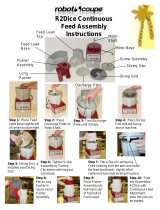
11
• Remove the batch bowl from the unit by rotating clockwise (left)
to disengage the tabs on the bottom of the bowl platform
from the batch bowl. When the bowl handle is on the left (about
7 o’clock position), you can gently lift the bowl straight up and out.
ASSEMBLY OF CONTINUOUS-FEED CHUTE PARTS
• Clean and sanitize the motor base, and wash, rinse, and sanitize
the continuous-feed chute, cover, slinger disc, food pusher,
small pusher insert and processing tools prior to initial use.
• Place the base on a counter or table near a 3-prong electrical
outlet. Position it so that you are looking at the front of the
unit and can see the control panel. Be certain that the cord
is unplugged. Do not plug in the cord until the processor is
completely assembled.
• Pick up the continuous-feed chute, holding it in both hands with
the chute pointing in the 4 o’clock position and the handle at
the 10 o’clock position. Place the chute on the base, tting its
center opening over the motor shaft.
• Press the chute down so the round lower rim of the chute ts
around the circular platform. Rotate counterclockwise until it
clicks into place and engages the rear interlock.
• Place the slinger (or ejector disc) in the bowl, sliding it over the
metal motor shaft until it reaches the bottom of the chute.
• Select the appropriate accessory disc. Follow directions on
page 9 to attach stem to disc.
• Place the cover on top of the chute with cover locking tab at
left of locking tab on chute. Press down and rotate the cover
until it latches to the tab on the continuous-feed chute. This will
prevent the lid from rising up during processing.
• The interlock tab on the cover will slide into the interlock slot on
the cover and engage the magnetic safety interlock switch. The
interlock switch prevents operation of the machine unless the
cover is in the proper position. With this switch engaged, the
food processor will operate if the power is on and the controls
are turned to ON or PULSE.
• To assemble the dicing assembly (WFP16S26) you may use only
the continuous feed. Do not attempt to use the dicing grid in
the batch bowl. First remove the continuous-feed chute cover
and be sure that the slinger is properly installed (see above for




















